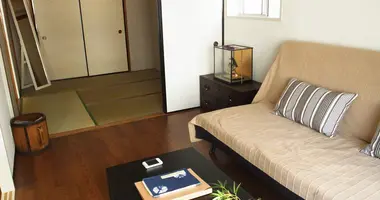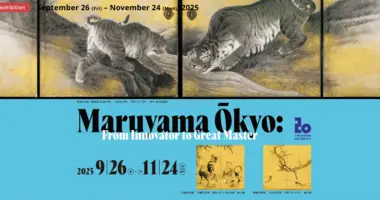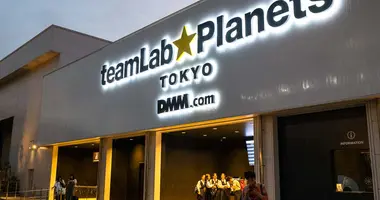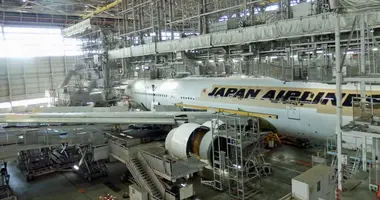Printing Museum Tokyo
- Published on : 25/01/2019
- by : Japan Experience
- Youtube
- Printing Museum Exhibits
- Temporary Exhibitions
- The Printing House Workshop
- Printing Museum Access
- Japan Museums
Printing Museum, Tokyo 印刷博物館 東京
Johannes Schonherr

Entrance to the Printing Museum, Bunkyo Ward, Tokyo, Japan
Walking through the streets of Bunkyo Ward in Tokyo, you often hear the typical rattle of printing machines from inside the buildings.
The area is the traditional center of the publishing industry in Japan. Kodansha, Japan's largest publishing company, has its headquarters in the ward. So do many smaller publishers as well as the businesses that manufacture the books - the printers and book binders.
Staying with that tradition, Toppan Printing, Inc., one of Japan's largest printing companies, founded in 1900 and by now active worldwide, also has its headquarters in Bunkyo Ward.
Located right beside the Kanda River and the elevated Shuto Expressway, the 21-story Toppan Koishikawa Building isn't entirely made up of offices, though. Its ground floor as well as its basement (B1) floor house the Printing Museum Tokyo.

Traditional Japanese movable letters

Museum logo and related artwork in the entrance area of the museum
Printing Museum Exhibits
The museum opened in 2000, the same year Toppan Inc. moved its headquarters into the newly erected structure. It consists of several sections.
The Permanent Exhibition features artifacts detailing the development of printing worldwide. This ranges from ancient Assyrian and Egyptian stamps and stone tablets to wood carvings and copper plate engravings to movable type printing.
The latter was first invented in China and then again in a much more advanced style by Johannes Gutenberg in Mainz, Germany in around 1450.
Gutenberg set the standard for the next 500 years until the industrial revolution brought offset printing and other mass production technologies to the forefront in the 20th century.
It is a fascinating story and the museum tells it very well, displaying a great variety of prints made using the various technologies as well as a great number of original historic printing tools.
The interaction of printing technology with developing cinematography is briefly featured as well as many other artistic and industrial branches that drew heavily on printing technology.
The tour doesn't end there - it goes straight to the latest in digital print and 3D viewing technologies.

Wood type printing blocks

Image of a European typesetting studio, 18th century
Temporary Exhibitions
The Printing Museum often features temporary exhibitions on printing related topics. The space that those temporary exhibitions encompass is often larger than the permanent collection itself.
Those temporary exhibitions tend to dig deep into certain aspects of printing history. An exhibition covering the topic of "Astronomy and Printing", for example, shed light on the publication of celestial navigation maps from ancient to modern times with a focus on Nicolaus Copernicus, the 16th century Polish astronomer who published the first book propagating the view that the sun rather than the earth is at the center of the universe.
Video screenings accompanied the exhibit, explaining the publishing history of Copernicus' work. He couldn't find a publisher in his native Poland but he did find one in Nuremberg, Germany, back then one of Europe's major publishing centers.
Though this particular exhibition has closed by now, expect a similarly deep focus from future exhibitions - whatever the particular topic might be.

American printing press from 1835 still in the use at the museum workshop

The Toppan Koishikawa Building in Bunkyu Ward, Tokyo, with Kanda River and elevated Shuto Expressway
The Printing House Workshop
The Printing House Workshop resembles a vintage type setter studio. Under professional guidance, visitors can create their own prints there, using the many movable letters and vintage printing presses available, including a very impressive printing press manufactured by W. Morris in the U.S. in 1835.
Long-term appointments for those workshops are not possible (except for groups). You do need however to enlist briefly before those workshops take place - and you need to be in front of the line. Please see the details and workshop schedule on the English-language website of the Printing Museum. www.printing-museum.org/en/bottega
Other Museum Features
A Virtual Reality Theater shows films related to printing history. Temporary but rather long-lasting exhibitions on topics like international book design take place next to the gift shop on the ground floor. Those exhibits can be visited for free.
Photo Policy
Taking any photos is prohibited in the exhibition areas. With the exception of the exterior shots, all images published here are official museum images.
Printing Museum Access
Printing Museum Tokyo
Toppan Koishikawa Building
1-3-3 Suido
Bunkyo-ku, Tokyo 112-8531
Tel. 03 5840 2300
(printing-museum.org website in English).
Opening times: 10 am to 6 pm (last admission at 5.30 pm). Closed on Monday, if Monday is a public holiday, the museum will be closed on the next day.
Admission for Permanent Exhibition: Adults 300 yen, college students 200 yen, middle and high school students 100 yen, elementary school students and younger free.
Admission fees for temporary exhibitions are considerably higher. They are about 800 yen for an adult, covering the permanent exhibition as well.
The museum website features an access map.
Edogawabashi Station
Edogawabashi Station on the Yurakucho Line (Exit 4), is an 8 minute walk away.
Iidabashi Station
Iidabashi Station on the Chuo-Sobu Line (East Exit), the Yurakucho Subway Line, Tozai Line, Oedo Subway Line and Namboku Line (Exit B1) is a 13 minute walk.
Korakuen Station (Exit 1)
Korakuen Station on the Marunouchi Line and Namboku Line of the Tokyo subway, is a 10 minute walk.
By Tokyo bus take either the 上69 bus from Ueno Park or the 飯64 from Kudanshita to the Higashigoken-cho stop (3 minutes from the museum).
Nearby
Tokyo Dome is a 15-minute walk east of the Printing Museum, with the Koishikawa Korakuen Gardens beside Tokyo Dome. Further east is the Bunkyo Historical Museum.
Hotels in Bunkyo, Tokyo
The Kanda area is a popular place to stay in the Japanese capital, being close to Tokyo Station, the electronics and cosplay capital that is Akihabara, Japan's top academic institution Tokyo University, and Tokyo Dome and its various fun attractions.
Choose from our recommended hotels and hostels in Tokyo.
Printing Museum Tokyo is housed in the HQ of Toppan Printing in Bunkyo-ku and displays a range of printing machines and other artifacts.




























